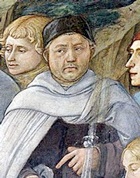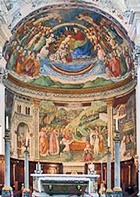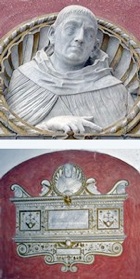Filippo Lippi (1406-69)
Umbria: Home Cities History “Foreign” Painters in Umbria Hagiography Contact


Filippo Lippi (1406-69)
Umbria: Home Cities History “Foreign” Painters in Umbria Hagiography Contact

The Florentine Filippo Lippi was an orphan who was raised in the Carmelite convent of Santa Maria del Carmine. Although he took vows there in 1421 and used the signature “Frater Philippus”, he was apparently blissfully unencumbered by his professed vocation. He left the friary in ca. 1433.
Filippo Lippi spent the greater part of his career in Florence. His earliest signed and dated work is the so-called Tarquinia Madonna (1437). He subsequently enjoyed the patronage of the Medici, as exemplified by his so-called Madonna in the Forest (ca. 1460), which was commissioned for the chapel in the Medici Palace.
Lippi’s only surviving work in Umbria is in Spoleto (see below). He died before the commission was complete, and was buried in the Duomo there.
Perugia
In 1461, Filippo Lippi assessed the frescoes (1454-61) by Benedetto Bonfigli of scenes from the Life of St Louis of Toulouse in the Cappella dei Priori (now part of the Galleria Nazionale). (Lippi, who was the only one of the three adjudicators named in the original contract who was still alive, was working in Spoleto at this time - see below). He judged that the work was well done and set the price at 400 Florentine florins.
Madonna and Child with saints (late 1460s)
According to Giorgio Vasari , “For the Church of of San Domenico Vecchio in Perugia, [Filippo Lippi] painted a panel that was afterwards placed on the high altar, containing a Madonna and SS Peter, Paul, Louis and Anthony the Abbot”. If Vasari's attribution is correct, Lippi probably painted this in the period 1467-9, immediately before his death, while he was also working on the frescoes in the apse of the Duomo, Spoleto (below).
Spoleto
Scenes from the Life of the Virgin (1467-9)

Monument to Filippo Lippi (ca. 1488)

According to Giorgio Vasari, the people of Spoleto initially buried Lippi in a red and white marble tomb in the Duomo. Lorenzo de' Medici tried to repatriate his body to Florence: this was probably in the 1480s, when Lorenzo was involved in a program to assemble the tombs of a number of famous Florentines in the Duomo of Florence. When the Spoletans refused to release the body, Lorenzo commissioned this more fitting monument to a design by Filippo’s son, Filippino Lippi. He apparently visited Spoleto for the purpose while en route for Rome, probably in ca. 1488.
The new monument was executed by an unknown but probably Florentine sculptor. The Latin inscription by Angelo Poliziano is written in the first person: in it, Filippo says that Lorenzo has given him refuge in a marble sepulchre after his initial poor covering. He also says that he has surprised Nature by his ability to reproduce her work in his art. The Medici arms are depicted under the fine bust of Lippi.
The monument was originally installed over the door to the sacristy. It was moved to the space in front of the Cappella del Sacramento (see below) during the re-modeling of 1638-44 and moved again to its present location in 1904 at the behest of Giuseppe Sordini. It is impossible to say how much of the original has been lost.



